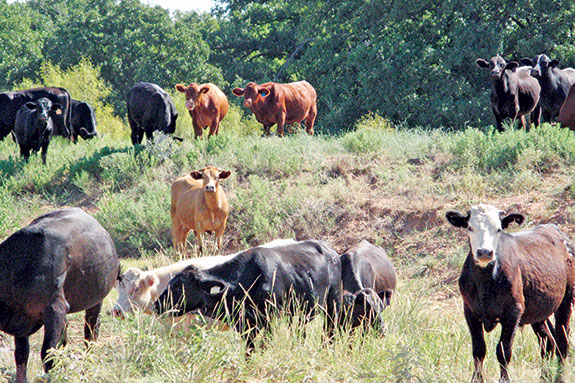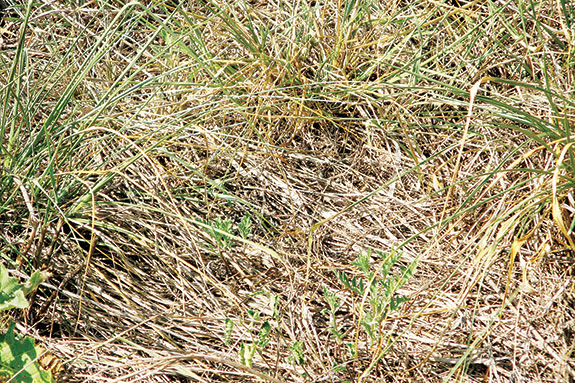The conclusion is that drought-resistant pastures can be created using holistic management.
Holistic management is a ranch planning system that utilizes resources to reap sustainable environmental, economic and social benefits.
Through holistic management, land can be returned to a healthy condition so productivity is greatly increased without large infusions of cash, equipment or technology.
Relationships between land, grazing animals and water are managed in ways that mimic nature.

“In holistic management, livestock density is increased to match available forage in order to maximize animal impact,” says Peggy Sechrist, Holistic Management Certified Educator with Holistic Management International (HMI).
“Hooves of animals pastured at a high stock density pulverize soil, allowing more water penetration and nutrient cycling.
Plants are grazed more evenly, and there is better distribution of forage utilization, urine and manure. High stocking density also causes a more even distribution of litter as a soil cover.
The layer of litter cools the soil, aids in water absorption and degrades into organic matter. Moving livestock to fresh manure-free ground results in improved animal nutrition and performance.
“Forage utilization is measured in animal days per acre (ADA),” Sechrist continues. “One ADA represents the amount of forage one animal consumes in one day and is easily converted to the actual square yards required to feed one animal for one day.
With practice, a land manager can learn to estimate the number of animal grazing days on a pasture and use the estimate to adjust stocking rates or grazing periods.”
Holistic management works
After visiting two or three ranches under holistic management, it is easy to believe in the system. Forrest Armke, manager of the Ford Ranch near Brady, Texas, has used holistic management for 25 years.
In November 2011, his pastures were covered with knee-high little bluestem grass and the ranch had only received four inches of rainfall since Jan. 1, 2011.
Total rainfall for the year was six inches compared to a normal annual rainfall of 24 inches. Cattle body condition scores ranged from 4½ to 5 in November.
“In 2012, Ford Ranch was very dry following the extreme dry year in 2011,” says Armke. “We only feed hay to our bulls and to heifers while they are having their first calves.
Last year we were able to harvest only 25 percent of a normal hay crop due to lack of rainfall. Our pastures suffered but retained a good ground cover and had moderate growth.
We grazed pastures for seven days and let them rest for 60 days. During the 60-day rest periods, we grew enough forage for another seven-day grazing period.
“We did not grow a surplus of forage in 2012 but were able to achieve enough recovery to maintain our existing herd numbers and retain 200 new replacement heifers,” Armke states.
“Ninety-eight percent of our cows including first-calf heifers re-bred. Most of our stock ponds are dry and cattle are watered with approximately 30 miles of pipeline. In this area, runoff from rain to replenish ponds has steadily declined each year for 10 years.”
Emry Birdwell and Deborah Clark use stocker cattle to intensively manage their ranch near Henrietta, Texas.
The ranch is divided into 50-acre to 90-acre paddocks. During the winter when cattle are purchased, they graze two or three herds.
Starting in March, herds are combined into one large herd that is rotated through the paddocks. The average rest period for a paddock from March until summer is 50 to 60 days.

By July of each year, if not sooner, the rest period is increased to allow ample time for grass recovery during the hot summer months. Summer rest periods vary from 90 to 120 days.
“During 2012, we had 3,100 head of cattle on native grass pasture and another 2,000 head on wheat,” says Birdwell. “Benefits of holistic management systems were evident in the performance of our cattle.
We had more weight gain last year than in any of the previous eight years that we have operated the ranch.
The more rapid rate of gain provided an opportunity to sell the cattle earlier in the year, providing additional rest for our pastures.
After selling in early summer, we restocked with lightweight cattle from July 20 until fall. Buying lightweight cattle was another way of conserving forage, since their grass consumption is less than that of heavier animals.
“Holistic management grazing increases plant diversity and returns rangeland to its condition prior to the overgrazing era of the 1800s,” states Birdwell.
“Our steers primarily graze little bluestem, Indian grass, switchgrass, blue grama and hooded windmill grass.
Big bluestem is slowly re-establishing after years of absence, and several previously overgrazed pastures on the ranch are showing recovery signs as a result of holistic management.”
USDA-NRCS adopts holistic management
The United States Department of Agriculture Natural Resources Conservation Service (USDA-NRCS) recently adopted the holistic management concept to help land managers improve soil health and reduce input costs.
Healthy soil is the basic requirement for producing good yields of any crop, regardless of whether it is grass, cotton or vegetables. It is very hard to increase yields or sustain production through a drought without healthy soils.
“If we understand the different components that contribute to soil health, we can increase infiltration rate and add organic matter, all of which can improve ranch profits,” says Ray Archuleta, conservation agronomist, NRCS.
“When we improve soil health, we address the majority of our natural resource concerns. The problem is that we have become detached from our land and no longer understand it.
We need to be able to diagnose soil health and design management strategies for improvement.”

Archuleta continues, “A cover crop is needed on the soil 24 hours a day, seven days a week to build organic matter, hold water and stop erosion.
Continuous live or dead cover helps maintain soil health and protects it from heat and raindrop impact. Soil needs armor.”
The need for continuous soil cover is one of the reasons pastures should not be grazed to bare ground.
Holistic managed grazing provides continuous soil cover and produces drought-resistant pastures. ![]()
Robert Fears is a freelance writer based in Texas.
PHOTOS
PHOTO 1: Peggy Sechrist and Forrest Armke standing in little bluestem grass on the Ford Ranch in November of 2011.
PHOTO 2: A fenceline comparison between continuous grazing and a holistic management system. The Birdwell Clark Ranch pasture on the right is under holistic management.
PHOTO 3: Stocker steers on the Birdwell Clark Ranch.
PHOTO 4: Litter produced by grass under holistic management cools the soil and produces organic matter. Photos by Robert Fears.









